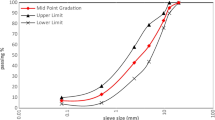Abstract
The main aim of mixture design is to select the best configuration of material in order to achieve mixture fabricating purposes. Aggregate make up a high proportion of volume and mass of mixtures, hence it considered as an important constituent of asphalt concrete. It has been hypothesised that the gradation is an important feature of the aggregate in adoption of optimum mixture. Three gradations are used to manufacture Hot Mix Asphalt (HMA) within special specification band of local code. Rutting resistance was evaluated using the Flow Number (FN) parameter and in order to determine the moisture sensitivity mechanism, a mechanical and visual inspection tests are carried out. The main conclusion of this study is that contrary to customary belief, middle gradation of select band does not produce the best results. Eventually some proposed factors, such as determining “sensitive mixtures” to binder content variation, have been determined for mixture design process.
Similar content being viewed by others
References
AASHTO (1997). In Standard specifications for transportation materials and methods of sampling and testing: Part II: Tests, Vol 2, American Association of State Highway and Transportation Officials, Washington, D.C., pp. 1040–1043.
Abo-Qudais, S. (2007). “The effects of damage evaluation techniques on the prediction of environmental damage in asphalt mixtures.” Building and Environment, Vol. 42, Issue 1, pp. 288–96, DOI: 10.1016/j.buildenv.2005.08.005.
Abukhettala, M. E. (2006). The relationship between marshall stability, flow and rutting of the New Malaysian hot-mix asphalt mixtures, MSc Thesis, Faculty of Civil Engineering, Universiti Teknologi Malaysia.
Clark, W., Wright, J., and Buu, T. (1980). Effects of Idaho aggregate gradation on asphalt paving mix, Research Proj. No. 87, p. 18.
Goh, S. W. and You, Z. (2009). “A simple stepwise method to determine and evaluate the initiation of tertiary flow for asphalt mixtures under dynamic creep test.” Construction and Building Materials, Vol. 23, Issue 11, pp. 3398–405, DOI: 10.1016/j.conbuildmat.2009.06.020.
Kandhal, P. S. and Cross, S. A. (1993). Effect of aggregate gradation on measured asphalt content, National Center for Asphalt Technology, NCAT Report 93–01, Issue No. 1417.
Kanitpong, K., Charoentham, N., and Likitlersuang, S. (2012). “Investigation on the effects of gradation and aggregate type to moisture damage of warm mix asphalt modified with Sasobit.” International Journal of Pavement Engineering, Vol. 13, Issue 5, pp. 451–8, DOI: 10.1080/10298436.2011.565058.
Khodaii, A. and Mehrara, A. (2009). “Evaluation of permanent deformation of unmodified and SBS modified asphalt mixtures using dynamic creep test.” Construction and Building Materials, Vol. 23, Issue 7, pp. 2586–92, DOI: 10.1016/j.conbuildmat.2009.02.015.
Kim, S. and Coree, B. J. (2005). Evaluation of hot mix asphalt moisture sensitivity using the Nottingham asphalt test equipment, In (Ed.), IHRB Project TR-483, CTRE Project 02–117, p. 65.
Pan, T., Tutumluer, E., and Carpenter, S. H. (2006). “Effect of coarse aggregate morphology on permanent deformation behavior of hot mix asphalt.” Journal of Transportation Engineering, Vol. 132, No. 7, pp. 580–589.
Sagi, S. V. (2004). The impact of acceptance criterion on HMAC moisture susceptibility, Department of Civil Engineering, The University of Texas at El Paso, No. 1423725, pp. 133–141.
Sánchez-Leal, F. J. (2007). “Gradation chart for asphalt mixes: Development.” Journal of Materials in Civil Engineering, Vol. 19, No. 2, pp. 185–97.
Sangsefidi, E., Ziari, H., and Mansourkhaki, A. (2012). “The effect of aggregate gradation on creep and moisture susceptibility performance of warm mix asphalt.” International Journal of Pavement Engineering, Vol. 15, No. 2, pp. 133–141, DOI: 10.1080/10298436.2012.752824.
Sengoz, B. and Agar, E. (2007). “Effect of asphalt film thickness on the moisture sensitivity characteristics of hot-mix asphalt.” Building and Environment, Vol. 42, No. 10, pp. 3621–8, DOI: 10.1016/j.buildenv.2006.10.006.
Solaimanian, M., Harvey, J., Tahmoressi, M., and Tandon, V. (2003). “Test methods to predict moisture sensitivity of hot-mix asphalt pavements.” Moisture Sensitivity of Asphalt Pavements-A National Seminar, pp. 77–110.
Trang Nhat, T. (2008). The relationship of bitumen content, aggregate surface area, and extraction time using asphalt ignition furnace, MSc Thesis, Faculty of Civil Engineering, Universiti Teknologi Malaysia.
Author information
Authors and Affiliations
Corresponding author
Rights and permissions
About this article
Cite this article
Sangsefidi, E., Ziari, H. & Sangsefidi, M. The effect of aggregate gradation limits consideration on performance properties and mixture design parameters of hot mix asphalt. KSCE J Civ Eng 20, 385–392 (2016). https://doi.org/10.1007/s12205-015-0265-8
Received:
Revised:
Accepted:
Published:
Issue Date:
DOI: https://doi.org/10.1007/s12205-015-0265-8




